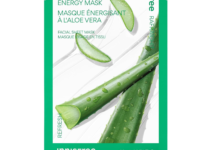[et_pb_section admin_label=”section”]
[et_pb_row admin_label=”row”]
[et_pb_column type=”4_4″][et_pb_text admin_label=”Text”]
I am a huge fan of using DIY toner recipes in my cheap skincare routine!
if there’s one thing you really never need to actually buy, it’s toner.
Seriously, once you find out how easy it is to mix up at home, you’ll never spend another scent on it again.
Keep reading to check out some of my personal favorite ideas for all skin types!

5 Super Easy DIY Toner Recipes for Every Skin Type
Most of these easy tone recipes require just two ingredients that you can usually find right in your grocery store!
Before we start, though, I just want to remind everyone that this is not medical advice.
If you have a skin condition, please talk to your dermatologist to find out which DIY skin toner is right for you.
FYI, this post contains affiliate links. If you make a purchase through these links, we earn a small commission at no extra charge to you.
1. Green tea & apple cider vinegar toner (for oily skin)
If you have oily and/or acne-prone skin, here’s one you’ll love!
Steep a green tea bag in a cup of hot apple cider vinegar (ACV) for about 5-10 minutes.
Then, let it cool and apply it at night after you cleanse your face.
The green tea acts as an anti-inflammatory (acne is basically an inflammatory response), while the ACV helps balance our your skin’s pH.
You can also try this toner recipe tutorial below for a different twist on my version:
2. Lavender & Sweet Almond Oil skin toner recipe
Here’s one of my favorites for dry or sensitive skin!
Just add about about 5 drops of lavender oil to 1/4 cup of sweet almond oil.
Sweet Almond Oil is my all-time favorite carrier for essential oils. It’s inexpensive, gentle, diverse, and loaded with benefits.
Lavender is also one of the gentlest essential oils. In fact, it’s one of the few that you can apply “neat” (without diluting).
I still prefer to add it to a carrier, though, just to be safe.
Check out the benefits of Sweet Almond Oil in the video below:
3. Rosewater Toner for sensitive skin
Rosewater is one of the gentlest toners for sensitive skin, but it’s a bit harder to make than the other ideas on this list.
The quickest and easiest way is to just add rose essential oil to distilled water. However, that’s also the most expensive way.
Real rose oil (versus cheap knockoffs) will cost you a very pretty penny. The real stuff rarely goes for under $50 per 5mL.
So, you’re better off buying yourself a bouquet of roses and using the petals to make your rosewater.
Check out the video below for an easy tutorial, or this link for 4 different ways to make it.
4. Lemon juice + aloe or coconut water
Good for “brightening” dull skin or lightening red spots.
Lemon is a natural source of alpha hydroxy acids, which are great for exfoliating dead skin cells.
I like to add it to aloe because I find it very soothing.
However, coconut water makes a wonderful alternative to aloe.
Whichever you choose, I either squeeze the juice of a fresh lemon into about 1/2 cup of liquid or add 3-4 teaspoons of bottled lemon juice (like Real Lemon).
Check out the video below to learn more about using it in your skincare routine.
6. Tea Tree toner for acne-prone skin
Tea tree is an amazing toner for acne, and it’s another one that’s safe to apply “neat.”
However, I prefer using it that way to target blemishes directly, rather than as a whole-face toner.
For that, I mix it with witch hazel for oily skin days or sweet almond oil for dry skin days.
As with the lavender oil recipe above, I add about 5 drops of tea tree per 1/4 cup of carrier.
You can adjust it up or down depending on your needs, though.
Check out the tutorial below for more tips.
FAQs about Using Toner
Before I send you on your merry way to whip up a new toner, I thought we should go over a few frequently asked questions about this part of your skincare routine.
Just what, exactly, is toner?
Toner is sort of what it sounds like- a liquid that helps “tone” your skin.
Depending on which type you use, it’ll either add a boost of hydration or help unclog stuffed-up pores.
Doesn’t toner dry your skin out?
Well, yes and no. Astringent toners have a high alcohol content, which is very drying to your skin.
However, while astringents are considered toners, not all toners are astringents.
So, the answer really depends on which type you choose as well as your skin type.
If you opt for witch hazel or tea tree oil and you already have dry skin, then yes, it’ll leave your face feeling a bit parched.
However, if you have oily skin, those ingredients actually provide a bit more balance when used in moderation.
How do you apply toner?
Like all things, there are actually a few ways to apply toner.
I take the simplest approach. I place the toner on a cotton ball, then rub it on my face in a circular motion.
You can also just put some on your clean dry hands and rub it into your face.
Others, like in the video below, use cosmetic cloths instead of cotton balls or their fingers.
When do you put it on?
Toner goes on AFTER you wash your face, but BEFORE your moisturizer, serums, or other skincare treatments.
According to Allure, you really should put it on within 60 seconds after cleansing your face, as that’s when your pores are most “receptive” to it.
I hope you enjoy these amazingly easy and cheap DIY skin toner recipes! If you have any other questions or comments, feel free to let us know below.
What are your favorite skin toner recipes? Share below!
[/et_pb_text][/et_pb_column]
[/et_pb_row]
[/et_pb_section]


